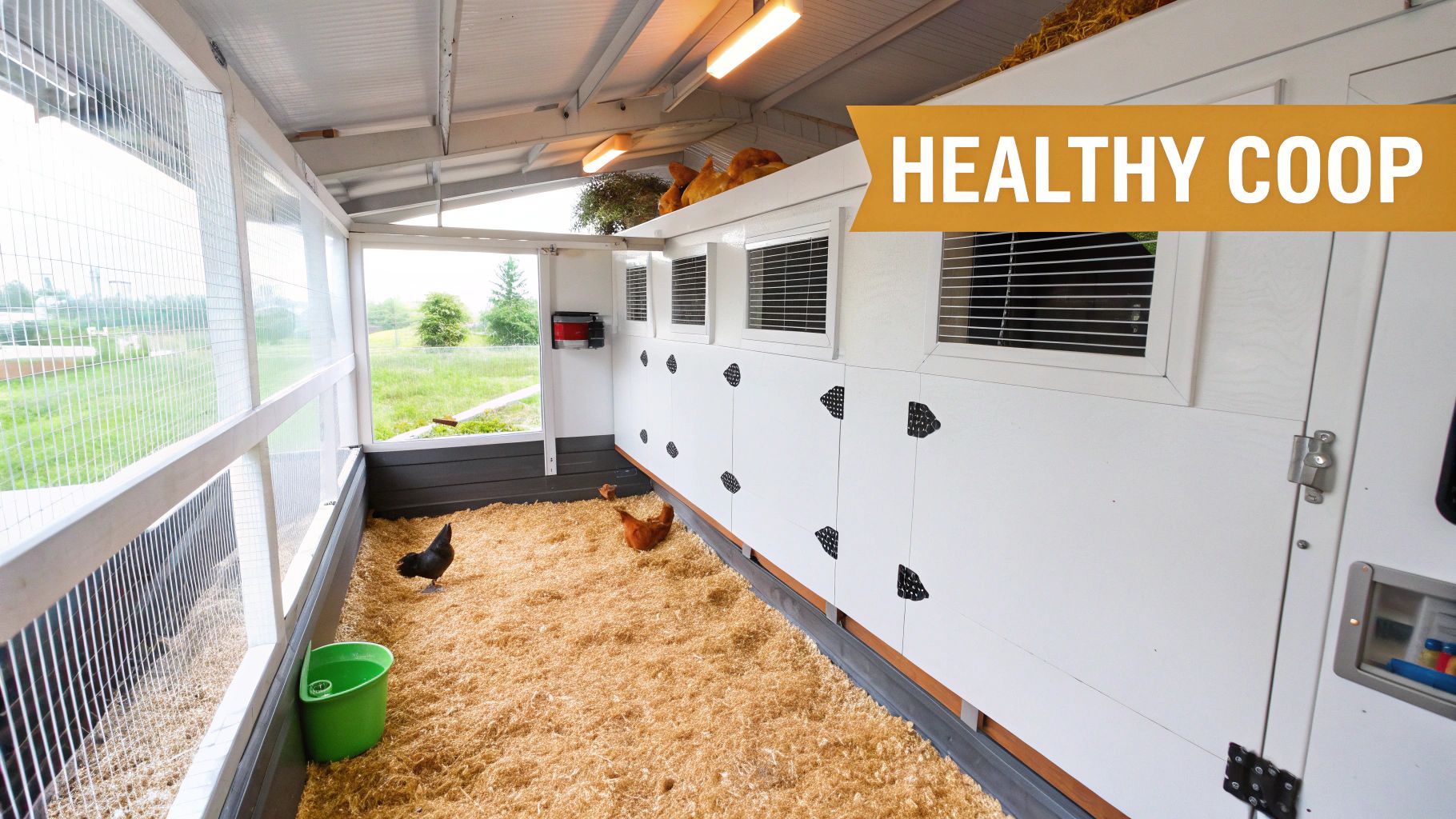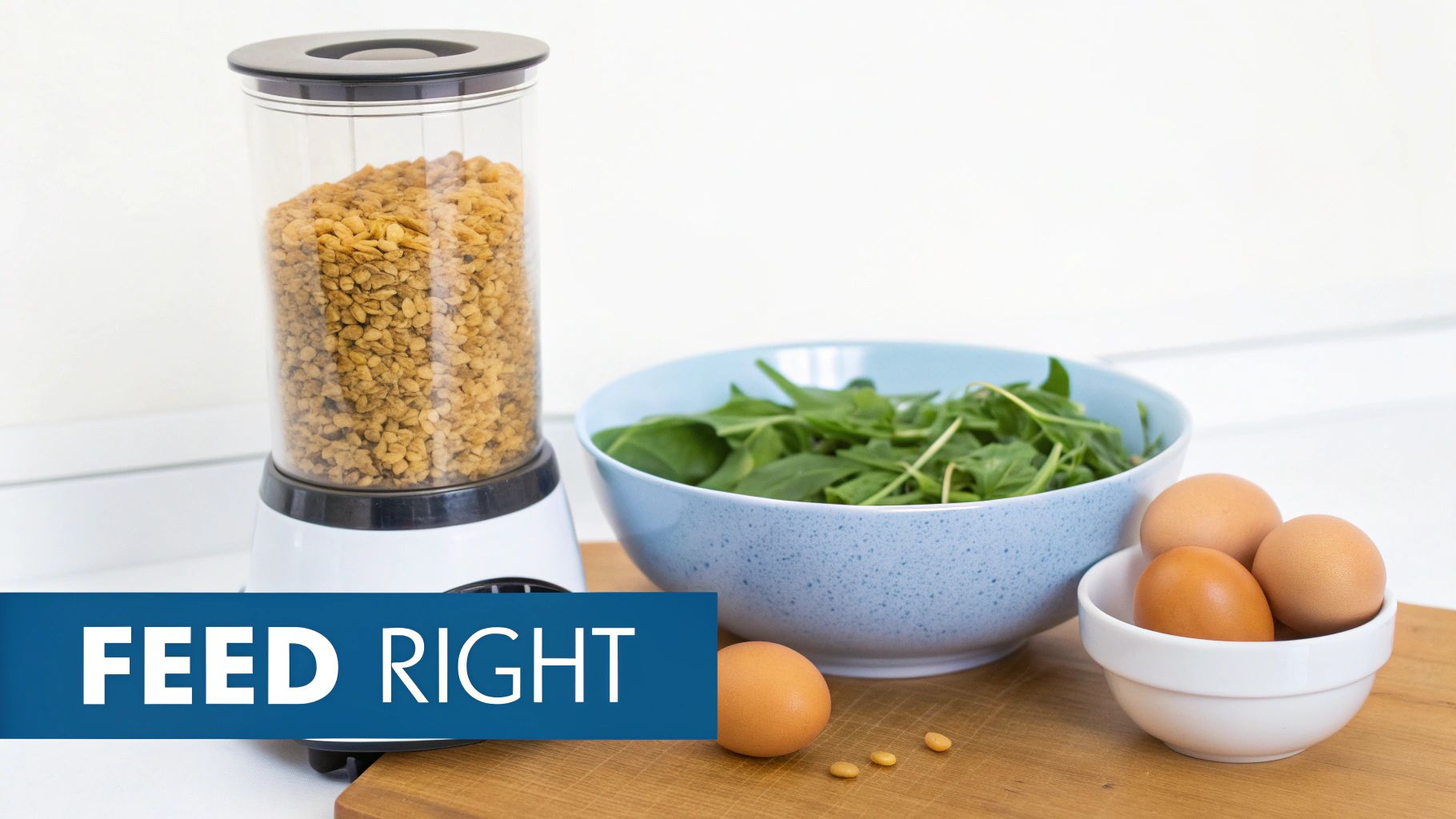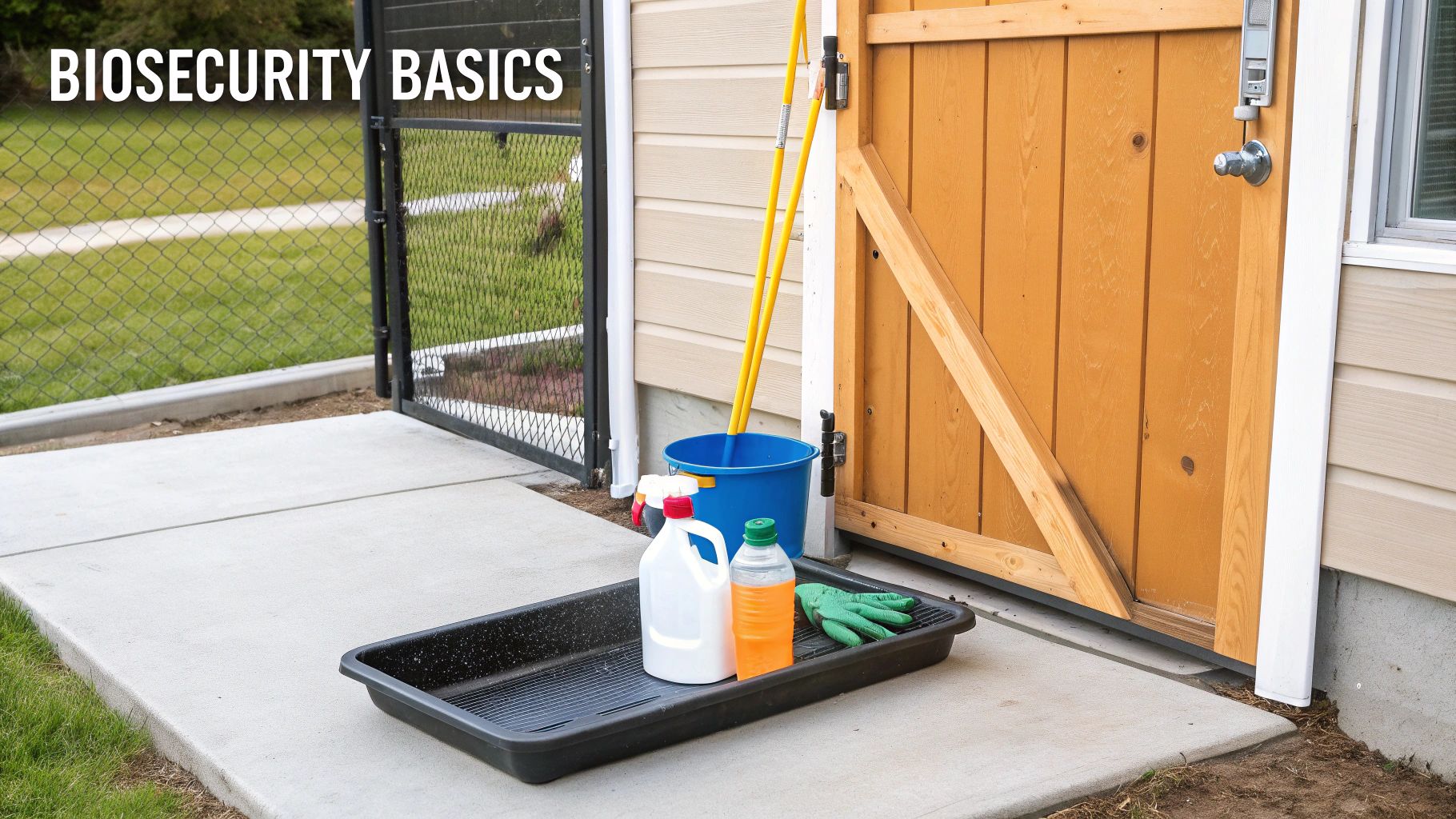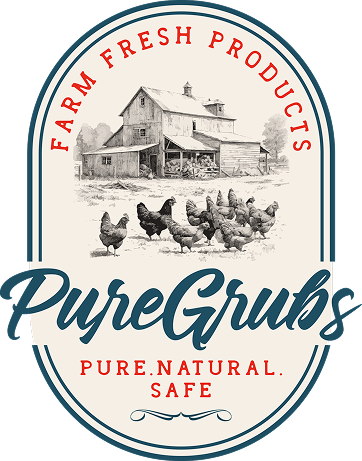
How to Keep Chickens Healthy A Practical Guide
Share
When it comes to keeping your chickens healthy, it really boils down to getting the fundamentals right. You don't need to be a veterinarian; you just need to be consistent. Think of it less as a list of chores and more as a daily rhythm you establish with your flock.
A proactive approach is always, always better than reacting to a problem. Building a strong foundation from the start will save you a lot of heartache down the road. It’s all about creating an environment where your birds can truly thrive, not just survive.
The Foundations of Flock Wellness
A happy, healthy chicken is one that feels safe, well-fed, and comfortable. Everything from the coop they live in to the food they eat plays a part. If you cut corners on any of these core elements, you create a weak spot that can lead to stress, disease, or parasite issues. It's a holistic system where all the pieces fit together.
The Four Pillars of Chicken Health
I've found it helpful to think about chicken care in terms of four main pillars. If you make sure these are always standing strong, you'll be in great shape.
-
A Secure, Clean Coop: The coop is more than just a house; it’s a fortress. It needs to be predator-proof, well-ventilated but free of drafts, and dry. Keeping it clean is non-negotiable for preventing parasites and respiratory problems.
-
Smart Nutrition and Hydration: Your flock's immune system is built from what they eat. A high-quality, age-appropriate feed is essential. Just as important is constant access to fresh, clean water—chickens drink a surprising amount, and it's critical for their digestion and overall health.
-
Proactive Biosecurity: This sounds complicated, but it's just about smart, simple habits. It means things like quarantining any new birds before introducing them to your flock and keeping wild birds from contaminating your feeders and waterers. It's all about preventing germs from ever reaching your chickens in the first place.
-
Daily Observation: You know your chickens better than anyone. A quick, five-minute check-in every day is your best tool. You'll learn their normal behaviors and be able to spot subtle signs that something is off long before it becomes a major issue.
A thoughtfully designed environment is your primary tool against disease. By focusing on prevention through these four pillars, you set the stage for a resilient, productive, and happy flock for years to come.
Getting these basics down is the most direct path to a healthy flock. If you're new to all this, our complete guide on how to raise backyard chickens is a fantastic resource that walks you through everything from day-old chicks to their first eggs. Building these habits from the get-go makes all the difference.
To make this even easier, here's a quick cheat sheet that summarizes these core responsibilities. Think of it as your daily and weekly checklist for a thriving flock.
The Four Pillars of Chicken Health At a Glance
| Pillar of Health | Key Action | Why It Matters |
|---|---|---|
| Secure & Clean Coop | Daily spot-cleaning of droppings; weekly bedding changes. Check for drafts and leaks. | Prevents ammonia buildup, which causes respiratory illness. A dry coop discourages mold and parasites. |
| Nutrition & Hydration | Refill feed daily; scrub and refresh waterers every single day. | Ensures a strong immune system and proper digestion. Clean water prevents bacterial infections. |
| Biosecurity | Keep feeders/waterers away from wild birds. Quarantine new birds for 30 days. | Stops diseases from entering your flock from outside sources. |
| Daily Observation | Spend 5-10 minutes watching your flock. Look for changes in posture, energy, or droppings. | Early detection is key to successfully treating illness before it spreads or becomes severe. |
Keeping this table in mind will help you build a routine that quickly becomes second nature. A few minutes of prevention each day is worth hours of treatment later on.
Building a Coop That Keeps Your Chickens Healthy

Think of your chicken coop as more than just a house. It's the command center for your flock's health, their safe haven, and your first line of defense against predators, parasites, and respiratory issues. Your birds spend a huge chunk of their lives in there, especially when the weather turns nasty, so getting the design right from the start is absolutely critical.
Let’s dig into the details that separate a basic box from a coop that truly helps your flock thrive.
Let it Breathe: Ventilation Without the Draft
If there's one silent killer in backyard flocks, it's poor air quality. Ammonia fumes from droppings build up fast, and so does moisture from the birds just breathing. This creates a nasty, toxic environment that wreaks havoc on a chicken’s delicate respiratory system. Good ventilation isn't a luxury; it's a necessity.
The trick is to get stale, humid air out and fresh air in, all without creating a cold draft right where they sleep.
- High Vents are Key: Place vents high up on the coop walls, well above the roosting bars. Hot, ammonia-laden air naturally rises, and these vents give it a place to escape.
- Low Vents for Fresh Air: You can add smaller, often adjustable, vents near the floor to draw fresh air in. Just make sure they aren't aimed directly at the roosts.
Here’s a simple test I always use: stick your head inside the coop and take a deep breath. It should smell earthy, maybe like pine shavings. If your eyes start to water or you get a sharp whiff of ammonia, you've got a ventilation problem that needs fixing.
Give Them Space and Keep it Dry
Cramming too many birds into a small space is a recipe for disaster. It stresses them out, which can lead to feather picking, bullying, and makes it way easier for diseases to spread. Giving your flock enough room is one of the easiest things you can do to keep them calm and healthy.
I always stick to this rule: at least 4 square feet of floor space per bird inside the coop itself. For the attached run, you’ll want at least 10 square feet per bird, though honestly, the more space, the better.
Bedding is your other secret weapon for managing moisture and odor.
- Pine Shavings: This is the go-to for a reason. It's super absorbent, smells great, and does a fantastic job keeping ammonia levels down.
- Hemp Bedding: A fantastic, if pricier, option. Hemp is ridiculously absorbent, has very little dust, and even contains natural antimicrobial properties.
- Straw (Use with Caution): It’s cheap, but straw is terrible at absorbing moisture. It mats down and can quickly become a breeding ground for mites and dangerous mold if you don't stay on top of it.
A dry coop is a healthy coop. Moisture is your number one enemy—it’s what allows harmful bacteria, coccidia oocysts, and mold to flourish. Your ventilation and your bedding need to work as a team to keep things dry.
And one last thing: never, ever underestimate a predator. Raccoons can figure out a simple latch in minutes. I've seen it happen. Always use a two-step lock on every door and nesting box, like a slide bolt paired with a carabiner clip. It might seem like a hassle, but it guarantees your flock is safe and sound every night.
Smart Nutrition for a Healthy Flock

Nothing has a bigger impact on your chickens' health, immunity, and egg-laying ability than what you put in their feeder. It's the engine that drives everything. This isn't just about keeping the feed topped off; it's about understanding what they need at every stage of their lives.
A chicken's nutritional requirements change dramatically from the moment they hatch. Giving the wrong feed during a critical growth phase can cause all sorts of problems down the line, from developmental issues to weak eggshells and a vulnerable immune system.
Match the Feed to Your Flock's Age
The easiest way to make sure your birds get exactly what they need is to stick with commercially formulated feeds. These are designed by experts to provide the right balance of protein, vitamins, and minerals for each life stage.
-
Chick Starter (Weeks 0-8): This is a high-protein feed, usually 20-24% protein, that gives tiny chicks the fuel they need for explosive growth. You can often find medicated versions, which are a good idea for protecting against coccidiosis—a nasty intestinal parasite that can be deadly for young birds.
-
Grower Feed (Weeks 8-18): As your chicks enter their awkward teenage phase, their protein needs dip a bit to 16-18% protein. This feed is all about supporting steady, healthy growth without rushing them into laying eggs before their bodies are ready.
-
Layer Feed (Week 18+): The moment your pullets start laying, their calcium needs go through the roof. Layer feed typically has around 16% protein but is heavily fortified with extra calcium to help them form strong, perfect eggshells day after day.
A word of caution: Never give layer feed to young, non-laying birds. The high calcium content can cause severe kidney damage. On the flip side, a laying hen eating grower feed will quickly tap out her body's calcium reserves, resulting in rubbery shells and brittle bones.
Thinking Beyond the Bag: Safe Supplements and Treats
A good quality commercial feed should be the foundation of their diet, making up about 90% of what they eat. But the other 10% is where you can really boost their health and provide some fun enrichment.
High-protein treats are a game-changer during the annual molt. Chickens are regrowing thousands of feathers, which are made almost entirely of protein. Black Soldier Fly Larvae (BSFL) are my go-to for this. They're packed with protein and come with a natural, highly-absorbable source of calcium.
Kitchen scraps can also be a fantastic treat, but you have to be careful about what you toss their way.
Good-to-Go Kitchen Scraps:
- Leafy greens like kale and spinach
- Cooked rice and pasta (in moderation)
- Berries, melon, and other fruits
- Oatmeal and other cooked grains
Foods to Always Avoid:
- Avocado pits and skin
- Raw potato peels (especially if green)
- Onions and garlic
- Anything salty, sugary, or highly processed
- Dried or undercooked beans
Ultimately, proper nutrition is your daily investment in the long-term health of your flock. If you want to dig even deeper into this topic, our guide on what is the best food for chickens has everything you need to know.
Practical Biosecurity for Backyard Keepers

"Biosecurity" might sound like a word for a commercial farm with thousands of birds, but it’s really just a commonsense approach to keeping your own flock safe. At its core, it's a set of simple habits that prevent diseases from ever getting a foothold in your coop. Think of it as an invisible shield protecting your chickens from germs.
These small, consistent actions are the best defense you have. A few smart precautions can save you from the heartache, stress, and expense of a sick flock. And the best part? Good biosecurity doesn't have to be complicated or costly.
Isolate All Newcomers
Hands down, the biggest risk to your flock's health is bringing in new birds and immediately adding them to the group. I don't care if they came from a pristine-looking farm or your best friend's backyard—chickens can be silent carriers of diseases, showing no symptoms at all. It's a gamble you never want to take.
Before you bring new birds home, have a quarantine area ready. This needs to be completely separate from your main flock, maybe a large dog crate in a well-ventilated garage or a small temporary coop on the opposite side of the yard.
- Duration: Keep new birds isolated for a minimum of 30 days. No exceptions.
- Observation: This is your chance to be a detective. Watch them every day for sneezing, coughing, lethargy, weird-looking poop, or anything else out of the ordinary.
- Separate Care: Always take care of your established flock first, then tend to the quarantined birds. After you're done with the newcomers, wash your hands thoroughly and change your shoes.
After a full 30 days, if the new birds look perfectly healthy, you can start the process of slowly introducing them to your flock. This one habit is probably the most important thing you can do to prevent a flock-wide disaster.
Create a Clean Barrier
Believe it or not, you are the most likely person to introduce pathogens to your chickens. Germs can easily hitch a ride on the soles of your shoes, on your clothes, or on tools you've used somewhere else. The solution is to create a simple, clean barrier.
Get into the habit of having a dedicated pair of "coop boots." Keep them right by the gate to the run, slip them on before you go in, and take them off as soon as you leave. This single step stops you from tracking in nasty bacteria or parasite eggs from the rest of your yard.
Keeping backyard flocks healthy is a small but important part of a much bigger picture. The global demand for poultry is massive; in 2022, China alone consumed an estimated 24,436 kilotons of chicken. This huge scale highlights why healthy practices are vital everywhere, starting right in our own coops, to ensure the well-being of the birds and the people who care for them. You can learn more about these global poultry trends at WorldPopulationReview.com.
Mastering the Five-Minute Health Check

One of the first things you learn about chickens is that they are masters of hiding illness. It’s a deep-seated survival instinct; in the wild, a sick bird is an easy target for predators.
This means by the time a chicken actually looks sick, the problem is usually pretty advanced and much harder to treat. But there's a simple, powerful way to get ahead of this: a quick health check. Turning this into a daily habit—maybe when you're refreshing their food and water—is the single best thing you can do for your flock’s well-being. It only takes five minutes.
What to Look For: A Head-to-Toe Checklist
You don't need to handle every single bird every day. The goal is to develop a keen eye for what’s normal for your flock. Just watch them as they mill around your feet, and you'll quickly learn to spot the one that's just a little "off."
Overall Behavior and Posture
- Energy Level: Is everyone active, scratching, and interacting with the flock? A bird that’s standing off by itself, looking lethargic, is sending up a huge red flag. Isolation is a classic sign of trouble.
- Posture: A healthy chicken stands tall and alert. If you see a hunched posture or a droopy tail, that bird is likely feeling unwell or is in pain.
Head and Face
- Comb and Wattles: These should be plump, bright, and a vibrant red (or whatever is normal for the breed). A pale, shrunken, or purplish comb can mean anything from dehydration to serious disease.
- Eyes: You want to see clear, bright, and wide-open eyes. Any discharge, swelling, or excessive blinking is a reason to take a closer look.
- Nostrils (Nares): They should be clean and dry. Any bubbles, discharge, or crustiness can be an early indicator of a respiratory infection.
Your daily check-in is your early warning system. Catching a pale comb or a slight wheeze on Tuesday gives you a massive advantage over discovering a seriously ill bird on Friday.
Interpreting the Signs
Beyond the obvious, a chicken's droppings and legs can tell you a lot. Healthy chicken poop is mostly a solid, brownish-gray mass with a distinct white cap (these are the urates). If you start seeing consistently watery, bloody, or oddly colored droppings, something is amiss. Getting familiar with the various symptoms of illness in chickens will help you connect the dots faster.
Don't forget to look down. Their legs and feet are just as important. The scales on their shanks should lie smooth and flat. If they look raised or crusty, you could be dealing with scaly leg mites. Also, keep an eye out for any limping, sores on their footpads (bumblefoot), or swollen joints.
This kind of daily observation is the cornerstone of proactive poultry care. It's a principle that drives the entire industry, from backyard keepers to large-scale farms. The global poultry nutrition and health market was valued at USD 7.04 billion in 2023 and is expected to climb to USD 11.1 billion by 2032, largely because of this growing focus on prevention and wellness.
Answering Your Top Chicken Health Questions
Even the most seasoned chicken keeper runs into new situations or has questions pop up. It’s just part of the journey. Let’s walk through some of the things I get asked about most often, with real, practical answers to keep your flock and your family safe and sound.
A common goal for homesteaders is to have different animals mingling together. One of the first questions is often, "Can my chickens live with my goats?" The short answer is yes, but it requires some smart management. The biggest danger isn't for the chickens, but for the goats—chicken feed can cause serious, life-threatening bloat in goats if they get into it.
The simplest fix is what's known as a "creep door." It's just an opening into the chicken's feeding area that's big enough for a chicken to slip through but far too small for a curious goat. This creates a safe, private dining area for your flock where they can eat in peace.
Can My Chickens Make My Family Sick?
This is a totally fair question, and the main thing to be aware of is Salmonella. Chickens can carry these bacteria in their gut without looking sick at all. The germs can easily get onto their feathers and feet and, of course, are present in their droppings. From there, it's a short trip to your hands.
Keeping your family safe is straightforward. Just make a habit of these simple rules:
- Always wash your hands with soap and water right after handling your chickens, gathering eggs, or touching anything inside the coop.
- Keep a close eye on kids when they're with the flock to make sure they're following the same hygiene rules.
- As tempting as it is, avoid kissing or snuggling your chickens. Keep them away from your face.
These habits are incredibly powerful for preventing any kind of cross-contamination and keeping everyone healthy.
Keeping chickens is a responsibility that extends beyond just the flock's health to your own. Simple hygiene is the most powerful tool you have to prevent the transmission of common bacteria like Salmonella.
Do I Need a Rooster to Get Eggs?
This is probably one of the biggest myths in the chicken world! Nope, you absolutely do not need a rooster for your hens to lay eggs. Hens will lay on a regular cycle all by themselves.
The only time a rooster is necessary is if you want to hatch fertile eggs and raise chicks. A rooster's only job in this department is to fertilize the eggs. Without him, any eggs your hens lay will be unfertilized and can never develop into a chick. If you're just raising a flock for fresh eggs to eat, a rooster is completely optional—and you get to skip all the crowing and potential attitude.
Interestingly, our focus on chicken health for food production brings up broader health topics. While we work to keep our chickens healthy for top-quality eggs, the health effects of eating chicken are also studied. Chicken is known as a lean protein, but some observational studies have drawn connections between high consumption and increased mortality rates. These findings aren't conclusive, but you can read more about these chicken consumption studies at FoxNews.com.
Ready to give your flock the ultimate health boost? Pure Grubs Black Soldier Fly Larvae are packed with the protein and essential calcium your chickens need for stronger eggshells, vibrant feathers, and robust immunity. Grown right here in the USA, our grubs are a safe, natural, and delicious treat your flock will go wild for.
